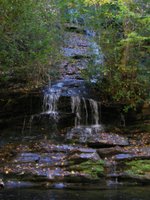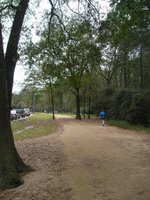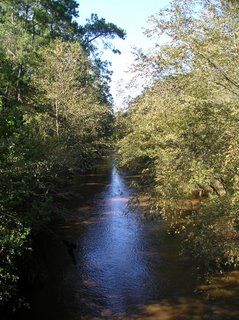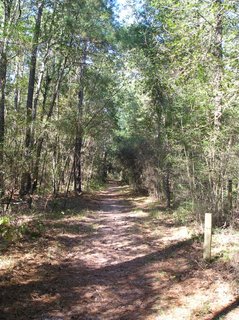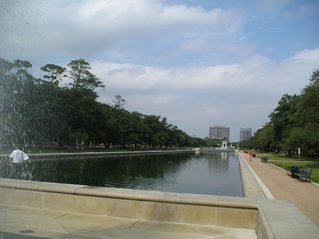 Introduction:
Introduction: If you've not been to the 445 acre
Hermann Park near the Medical Center in Houston lately, you're missing out. In the past few years, the Hermann Park Conservancy, in conjunction with the City of Houston, have made world-class improvements that make this park a true jewel.
Location: Maps are at
http://www.hermannpark.org/directions.htmlThere is an error on this directions page, but if you scroll down, at the bottom of the page above, there is a map of the location, written directions and also a PDF map of the park at
http://www.hermannpark.org/documents/Hermann_Park_Map_with_Greenway.pdf The park is south of downtown, north of the medical center off Main St. at Montrose/Hermann Drive. The entrance is at Mecom Fountain and the Sam Houston statue. There also is a Metro rail stop at the park on Main St.
Scoring: Walking = 4.5 Nature = 4Walking: the park loses points for not having signage that tells you where to walk and how long the trail is, as well as occasionally muddy path sections.
Nature: the park loses points for not having much in the way of natural woods. It's mostly groomed although moderately to heavily wooded.
(graded on scale of 1(bad) to 5(excellent), but based on what is available on Houston. For example, a 5 in Houston (the best) is not = to a 5 nation-wide, think Grand Canyon, Rocky Mountains, etc.)
Background: The park includes, not only the Houston Museum of Natural Science (including IMAX and the Butterfly space), but the Houston Zoo.
Also in the park are the Molly Gibbs and Jesse H. Jones Reflection Pool,
the Molly Ann Smith and Sara H. and John H. Lindsey Plazas,
and the recently enlarged McGovern Lake which include three new islands as well as bird and wetland habitat area.
Japanese Gardens
80 additional acres have been added to park along Brays Bayou
Miller Outdoor Theatre
Hermann Park Golf Course
Hermann Park Miniature Train track
What that means for Houstonians and visitors is a beautiful, well-lit park with art, walkways, water features, trees and landscaping and more.
Coolest Thing About Park: Three fountains at reflection pond and occasionally very cool "urban experiences" in this park. Have come across Russian group singing, Tai Chi group practicing, guitar music, an old man fishing with old fashioned gear from China and playing on a Chinese stringed instrument, and, of course, rehearsals at the Miller Outdoor Theater (dance, opera, plays, concerts, etc.)
Trails: If you enter Hermann Park through the main entrance near the Mecom Fountain on Main St. you'll see the newly rebuilt reflection pond on your right with parking adjacent to it. There is a one mile (more or less depending on route) walk around the lake, starting at the reflection pond, turn right to go over the bridge, left around by the children's playgrounds, turn left to go by the zoo, and left again to continue along the lake and by Miller Outdoor Theater and back to the reflection pond. You can extend this walk by taking all the curves and by going through the Japanese Garden which is adjacent to the reflection pond. Miller Outdoor Theater has a "hill" that is perfect for getting a boost out of your walk or jog. Try running or walking up and down and around it a few times. If instead you cross the street at the Miller Outdoor theater, you can take a two mile level track around the golf course. Or walk through the rose and herb gardens at the Houston Garden Center. You may also cross Main Street where there is the three mile track around Rice University. So depending on route, you can easily do one, two, three or six miles by combining these. More than half the walks are under large trees and in the shade. Most walkways are asphault, concrete or crushed granite walkways. There is some puddling and mud on the walkways after rain, but easily walked around.
There is also a walk along Brays Bayou which connects to the walk near the rose garden and golf course. I'm not comfortable walking this somewhat isolated trail alone (being a female), but it's a great walk with someone. Not much shade though. It connects with other bayou walks, so you can walk a lot farther.
Other things you'll want to know:
1. Water fountains all around the lake, but none on the two mile trail or the one around Rice University.
2. Shadiest walk is the two miles around golf course.
3. Noisy along side streets for part of two mile trail and all around the Rice University trail.
4. Would not walk any of these after dark.
5. Wildlife includes birds, ducks, geese, turtles, frogs, squirrels, snakes, fish.
6. There are three fountains around the reflection pond which make great places to cool off while walking in summer. Additionally, the children's playgrounds have water sprinklers shaped like trees and tunnels where you can cool off as well. There is a big button on a pole that you push for the water to start.
7. Watch for flying golf balls when going around the golf course track.
8. Restrooms are at Miller Outdoor Theater, children's playground, Japanese Garden, and rose garden. There are no restrooms on the two mile track around the golf course.
9. For safety, take your cell phone and ID. Walkways are fairly even, but cyclists and joggers use same trail, so you'll need to pay attention. Usually enough people are around during daylight hours for you to feel comfortable walking alone. There are usually security people around Miller Outdoor Theater and almost always some park maintenance folks around.
11. Signage in park could be much improved, but you really can't get lost. Maps are available online at
http://www.hermannpark.org/directions.html12. Parking can be a problem when major events are planned in park or on brilliant summer weekend days.
All blog content is copyrighted, all rights reserved, Mary Anne Fields and Life Unfolds, 2006
Feel free to add any comments you think would be useful to others about Hermann Park.


















